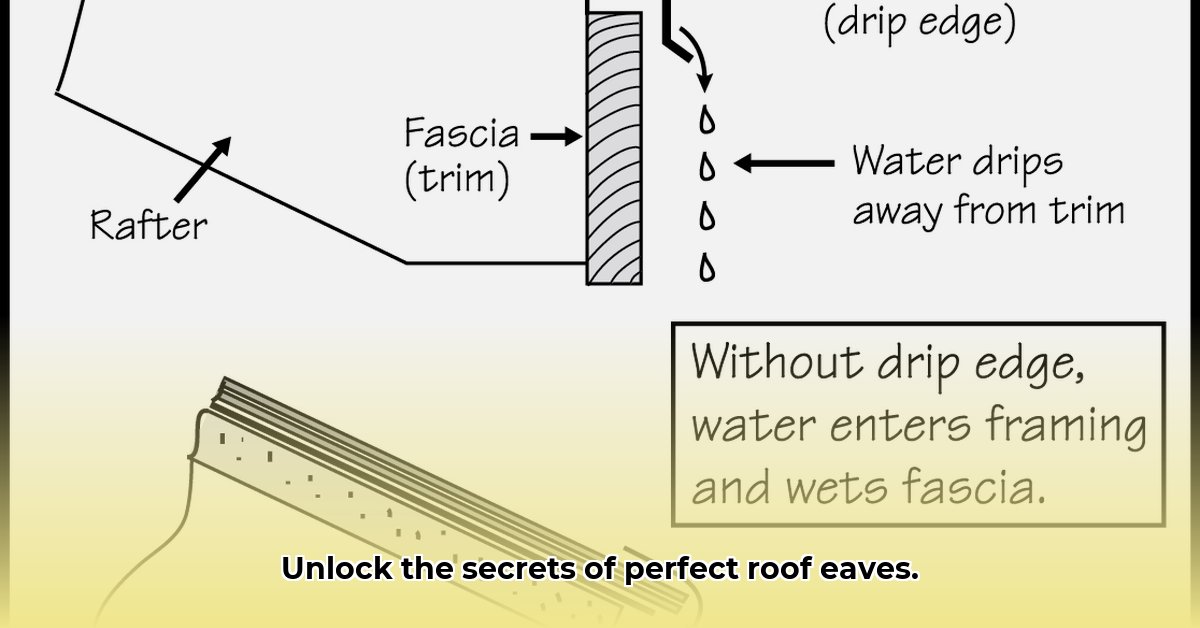Ever wonder about those overhanging edges on your roof? Roof eaves are more than just aesthetic details; they’re crucial for your home’s protection. This guide covers everything from eave types and functions to maintenance and repairs, offering insights for homeowners and professionals alike. Discover how eaves impact energy efficiency, pest control, and curb appeal. Become an eaves expert and learn how this vital feature protects your greatest investment.
Roof Eave: Your Home’s Unsung Hero
Roof eaves are architectural features that provide protection and enhance curb appeal. Understanding their various types and functions can prevent future headaches and save money. Discover how this often-overlooked feature contributes to your home’s well-being.
Getting to Know Your Eaves: A Variety of Styles
Roof eaves serve as a finishing touch to your home’s roofline, combining decoration with essential functionality. Various types exist, each offering unique aesthetics and advantages.
Open Eaves: The Classic Charm Offensive: Open eaves expose the roof’s rafters, providing a rustic and welcoming appearance. These are common in Craftsman bungalows and farmhouses, offering cost-effectiveness and simplicity in construction. However, open eaves provide less protection from rain, snow, and pests, potentially increasing maintenance needs and the risk of infestations.
Closed Eaves: Sleek and Protective: Closed eaves conceal the rafters with a fascia board, creating a cleaner and more modern appearance, often seen in contemporary homes. Offering improved water and snow deflection compared to open eaves, closed eaves are better at preventing pests from entering your attic, though regular inspections are still recommended to ensure complete protection.
Boxed Eaves: The Ultimate Protection Plan: Boxed eaves fully enclose the rafters, soffit, and fascia board, providing a sealed structure. This design provides superior protection from the elements and offers a sleek, minimalist aesthetic. These are ideal for homes in harsh climates, offering enhanced protection against extreme weather conditions, but can be more complex and costly to install.
Abbreviated Eaves: Less is More (Sometimes): Abbreviated eaves feature a shorter overhang, providing minimal shade and protection while maintaining a clean, modern look. Well-suited for minimalist designs or areas with limited space, abbreviated eaves offer elegance without the extra maintenance, however, homeowners should be aware of the reduced protection from the elements and potential increase in siding wear.
Eaves: More Than Just Pretty Faces – The Functional Side
Roof eaves play a crucial role in your home’s functionality and longevity, extending beyond mere aesthetics. Consider them vital, hardworking components of your property.
Water Management – The First Line of Defense: The primary job of roof eaves is to channel rainwater away from your home’s foundation. This prevents water damage to walls, basements, and surrounding landscaping. Careful planning and seamless gutter installation are essential for effective water management, minimizing potential water-related issues.
Shading and Energy Savings – The Natural Air Conditioner: Wide eaves act as a natural awning, blocking intense summer sun and reducing heat entering your home, which lowers cooling costs. However, energy savings depend heavily on climate; in colder climates, eaves might block beneficial winter sun, potentially increasing heating costs. The amount of savings is highly variable and hinges on accurate calculation and design.
Pest Control – Keeping the Unwanted Guests Out: Closed eaves prevent unwanted guests like birds, squirrels, and insects from nesting in your attic. Regular inspections are vital to ensure no unwelcome visitors enter through cracks or openings, maintaining a pest-free and healthy living environment.
Maintaining Your Eaves: A Little Care Goes a Long Way
Regular maintenance keeps your eaves in top shape and prevents costly repairs. Consistent upkeep significantly extends the lifespan of this key architectural element.
1. Gutter Cleaning: Clean gutters twice a year, especially in areas with many trees. Clogged gutters can overflow, damaging your home’s foundation and siding. Regular maintenance ensures that the roof drainage system functions efficiently.
2. Regular Inspections: Check your eaves yearly and after severe weather for rot, insect infestation, loose fascia boards, or wear and tear. Early detection enables timely and cost-effective repairs, preventing further damage to your property.
3. Addressing Damage Promptly: Address repairs immediately. Small problems can escalate quickly. Contact a professional roofer or contractor for help. Experienced DIYers can handle minor fixes, but professionals ensure proper structural integrity for significant repairs, providing long-term protection.
4. Material Matters: Eave materials—wood, PVC, or metal—affect maintenance needs. Wood eaves require periodic painting or staining to prevent rot, while PVC and metal options are generally low-maintenance, but can be susceptible to damage from impact or extreme weather conditions. Metal eaves may corrode or rust over time if not properly treated.
Eave Design and Cost: Finding the Right Fit for You
Choosing the right eave style depends on your climate, architectural style, and budget. Wide overhangs are great in hot climates for shade but can lead to snow and ice buildup in colder areas. Consider the architectural style of your home, local climate conditions, and financial constraints to make an informed decision.
| Eave Type | Pros | Cons | Estimated Repair/Replacement Cost (USD) |
|---|---|---|---|
| Open | Appealing aesthetic, good ventilation | Offers limited protection, may attract pests | $500 – $2000+ |
| Closed | Superior protection, stylish look | May have less ventilation than open eaves | $700 – $3000+ |
| Boxed | Excellent weather protection, modern design | Usually the most costly option | $1000 – $5000+ |
| Abbreviated | Sleek and minimalist, low-maintenance | Offers minimal protection | $300 – $1500+ |
Remember: These are estimates only. Costs vary widely based on location, materials, labor costs, and complexity. Always get multiple quotes from reputable contractors before making decisions. Factors like regional pricing differences and specific project requirements contribute to the overall cost.
Investing in well-designed and properly maintained eaves protects your home’s long-term health, value, and curb appeal. It’s a worthwhile endeavor that enhances your greatest investment.
How to Calculate Roof Eave Overhang for Energy Efficiency
Calculating the proper roof eave overhang can significantly enhance a building’s energy performance. Optimal lengths vary greatly based on location and building orientation. Explore how to achieve greater energy efficiency with this key design feature.
Key Takeaways:
- Proper eave design significantly impacts a building’s energy performance.
- Optimal overhang length varies greatly depending on location and building orientation.
- Simple online calculators offer initial estimates, but professional design is recommended for complex projects.
Understanding Eave Types
Different types of eaves exist, and their design directly influences your home’s performance. They serve specific purposes, like architectural eyebrows.
We have open eaves, which are simple, exposed rafters. Closed eaves, on the other hand, have a fascia board covering the rafter ends. Boxed eaves offer a more finished look, enclosing the soffit and fascia (the underside of the eave). The choice influences not just looks but also maintenance and energy efficiency; considering the varying energy performances of each, consult energy efficiency ratings and assessments.
Eave Function: More Than Just Looks
Eaves are functional workhorses, managing water runoff and providing shade. Properly designed overhangs minimize solar heat gain during summer, reducing cooling loads. This is where how to calculate roof eave overhang for energy efficiency comes in. Cleverly designed eaves can even help direct winter sunlight into your home, but must also account for seasonal sun angles and local climate conditions.
Maintaining Your Eaves: A Prevention Plan
Regular maintenance is key to maximizing eave lifespan. Keeping gutters clean prevents clogs and overflow, protecting your home’s exterior. Regular inspections for rot, pest damage, or leaks are crucial. Addressing minor issues early avoids costly repairs. The materials used—wood, PVC, or metal—will influence maintenance needs. Schedule regular inspections, ideally twice a year, to promptly identify and address potential issues.
Designing for Energy Savings: Location, Location, Location
The optimal eave overhang isn’t a one-size-fits-all solution. It depends heavily on your location (latitude), the building’s orientation, and the climate. South-facing eaves need careful consideration to maximize winter sun gain and reduce summer solar heat. Detailed climate analysis and advanced modeling software become invaluable. Local building codes matter, especially when it comes to overhang dimensions, and must be taken into consideration.
Calculating the Perfect Overhang: Tools and Techniques
How to calculate roof eave overhang for energy efficiency is not a simple formula. Simple online calculators are great starting points but have their limitations; they give a general idea but lack the precision of professional design software. Consider consulting an architect or experienced builder for a truly optimized design. They’ll factor in your unique location, climate, and building design. Sophisticated methods involve calculating solar angles to strategically optimize overhang dimensions.
Eave Overhang Costs: What to Expect
Repair and replacement costs vary greatly based on materials and complexity. Minor repairs might cost a few hundred dollars, while major replacements can run into thousands. Material choices, design complexity, and labor costs must be carefully evaluated.
Essential Eave Design Considerations For Architects – Expert Insight
Understanding eave design is crucial for architects to protect homes from water damage and excessive sun. Different eave types offer various aesthetic and functional benefits. Explore the essential considerations guiding eave design.
**Key Take
- Backsplash For Gray Cabinets: Choosing the Right Backsplash Style - December 13, 2025
- Gray And White Backsplash: Ideas For Timeless Style - December 12, 2025
- Gray Kitchen Backsplash Ideas: Find Your Perfect Gray Tile - December 11, 2025









